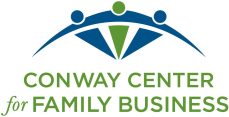By Conway Center Service Provider Jennifer Griffith, Ohio Regional President of First Merchants Bank.
Recently, First Merchants introduced a new approach to defining employee engagement that has launched several great follow–up conversations and planning opportunities. The “old approach” was to measure employee loyalty + employee contribution to solve for the company’s ability to drive employee engagement. The ownership landed in the lap of leaders. Our recent approach unites maximum job satisfaction with maximum job contribution (very similar) but solves for the shared responsibility of engagement and the ability to drive engagement as a daily priority.
The model starts with the individual’s accountability for clearly communicating what is important to them and then layers on the role of management and the executive suite. Managers and executives are individuals first. We know dead batteries can’t jump– start others, so it is crucial that managers and executives are individually engaged each day. Only then can they lead an engaged workforce.
In addition, the model highlights that an engaged employee is at his or her best when individual contribution and corporate contribution are at maximum levels. Makes sense, right? But it goes on to highlight how important it is to unite both. An employee may find they are fully satisfied with their work but not connected to the business and, therefore, be at risk for turnover (i.e. disengagement). Likewise, an individual may perfectly understand how his or her work contributes, but not be satisfied with their role. The beauty lies in the unity of both.
This model is extremely appealing to me for multiple reasons. First, there is an easy to see team–based approach. Disengaged employees are costing you money! Whether it’s the opportunity cost of not performing or the presence of bad energy, disengagement needs to be abolished in order for your business to thrive! Engaged leadership can model the way, but you will never be able to substitute in your engagement. That is up to the individual player.
The model also refers to engagement as a daily priority. It introduces the belief that engagement is fluid. It’s not a report card or a stamp in time. Engagement ebbs and flows. This makes perfect sense to me as we introduce the accountability of the individual. Not every day is a great day – some days are really tough! One of my mentors repeatedly asks me if I’m having fun four out of five days. It is a great question.
Finally, the model highlights that managers and executives are employees too – individuals first. As individuals, executives can have a bad day too…but if they plan to lead a growth–oriented, profit–driven company with employees that are working at maximum contribution and personal satisfaction, then daily engagement might just be the game–winning strategy!
For information about the engagement model or vendor resource, please feel free to contact her directly at 614.583.2050.

